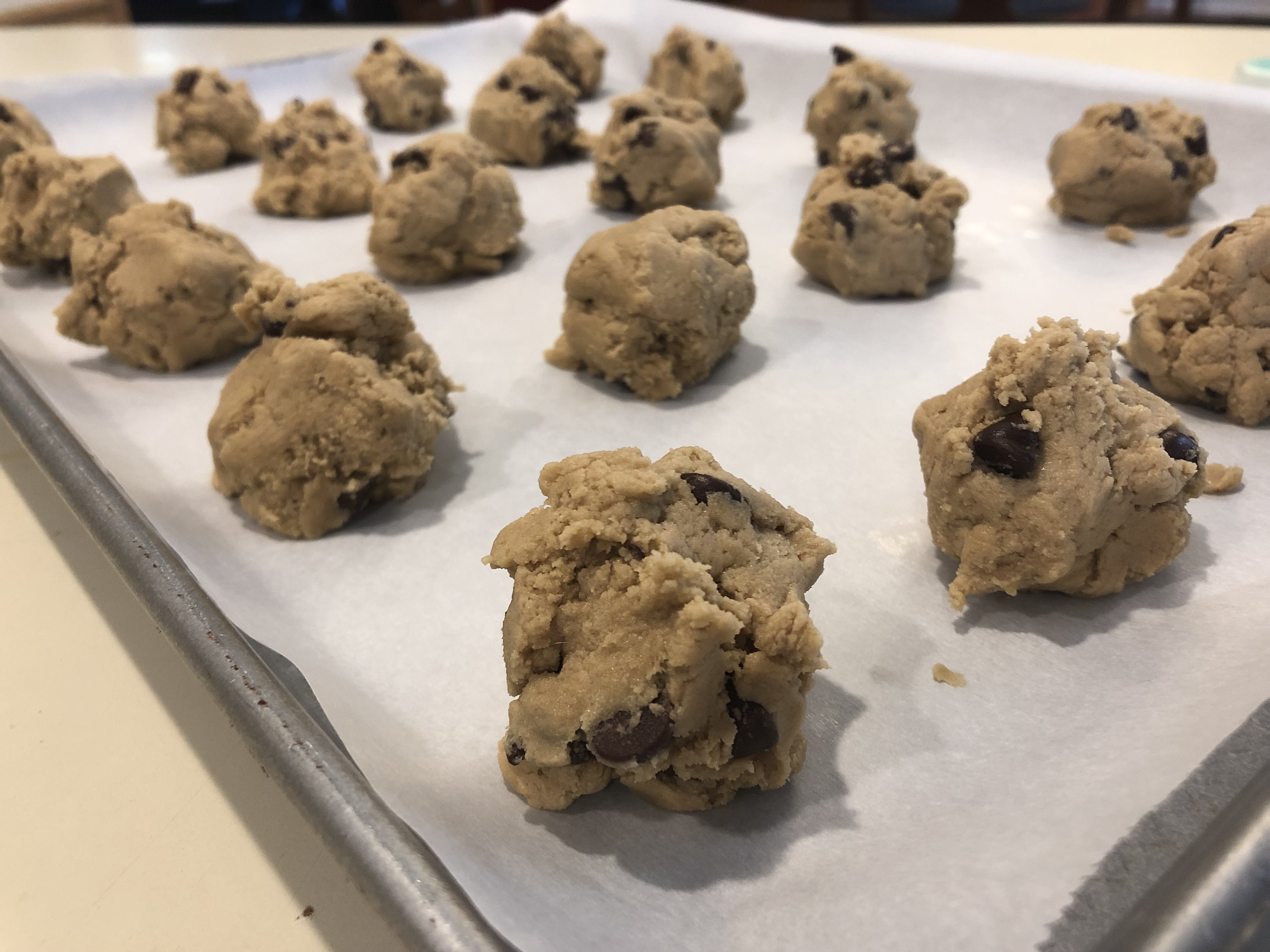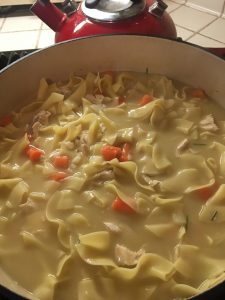

I make this soup. It’s not really one kind of soup; it’s any; it’s many. It starts out the same every time, but it ends up different if I want it to, and I know how to make it because my mom died eighteen years ago.
I had to count up those years in my head just now because I can’t believe it’s been that long; it seems like just a few years ago she was walking around in a Lands End down vest and jeans (still a good look, I might add), and chatting with me, sewing, watching re-runs of Newhart. Laughing, at everything I said. She thought I was so funny. She died in a freak accident that I wasn’t there for and left us all pretty broken. And no good came of it, either. All those aphorisms about how something good comes of everything, how we will see the wisdom in God’s plan years later; all those do not apply. No good came of losing my mom, period, and definitely not one large enough to make up for the gaping, yawning hole that was left in my family. But if I had, I mean absolutely had to think of something good, or sort of good, that happened in the years that followed that might not have happened if I hadn’t lost my mom, there are two things: I became a little more compassionate, and I learned to make soup. Seriously good, comforting, delicate-yet-substantial soups that warm the soul literally and figuratively.
I’m a very competent cook when it comes to weeknight dinners and sweet breads. I make great pot-roast, decent pot-pie, and adequate quiche, but I’m gifted at soup. I don’t like to brag, but I am. No recipe, just me and the contents of my fridge and pantry, no matter what they are, and I can make a soup that is amazing. My husband names them after me: there is ‘Paigestroni’ and “Paige-sta e fagioli,’ and my favorite, “Myrtle-ini.” (Don’t ask.) The guy is a bit of a foodie, too, and holds the culinary world to very high standards. He recently called me ‘the soup whisperer.’
Here is how it happened: my mom died, I lost eleven pounds in three weeks because I couldn’t choke down any sort of food, only nobody noticed except my roommate and my boyfriend, and then I learned to make soup. One night as I sat grading papers, because life just marches on in your face and you have no choice but to do what you’re supposed to be doing, my then-boyfriend stopped by with chicken parmesan from the Italian place downstairs that I liked until I stopped eating. I loved their chicken parmesan, and he tried to coax me into taking some bites. He held them out on a fork for me, like I was a toddler, begging me to just have some, because I needed to eat. I was teaching full time, six different classes with five different “preps” because the school I taught at was using me as a workhorse, and I was driving home to Alexandria three nights a week and leaving food for my dad. Casseroles, mainly, that he wasn’t eating. The boyfriend sat back on his haunches and asked if there was anything that I would eat. Anything that sounded good, and he’d go and get it for me, or make it for me. I came out of my stupor for a minute when I realized he seemed about to cry. (And by the way, it’s not that I was too thin–I could stand to lose eleven pounds then and I definitely could now. It’s just that my rapid weight loss was such an obvious symptom of my sadness, he thought if he could at least fix that, he’d have done something good. It wouldn’t have fixed the sadness, it was pure man-think, but he meant well.) I thought a minute and said, “Soup. I could eat soup. But…I think I want to make it myself.”
He was so pleased. I hadn’t wanted to do anything myself, let alone anything involving food, which he believed holds near-sacred qualities if prepared in a way that gives glory to God and food itself, and is consumed with family or friends. Really, I just wanted to make it myself because I wanted to make extra for my dad so I could skip a couple days of casserole-making. And I kind of wanted to be alone in my grief, because I was miserable company and knew it.
My boyfriend and my roommate got all excited, fluttering around arranging spoons and spatulas and cutting boards for me in the tiny kitchen of the hugely overpriced two-bedroom apartment. It was a crummy little place with peeling paint and stinky, sticky carpet and raccoons in the attic, but it had a kitchen with gas burners and a long countertop. “Do you need anything?” they kept asking, so I sent them to the store for chicken broth while I got to work chopping the one little onion we had. They said they’d get more onions, but I didn’t want more. We were on a tight budget, all of us, about half a shoestring each, and I wanted to see what I could do with what we had and very little else. The self-denial was strangely cathartic.
In the 20-year-old fridge we had some boneless, skinless chicken breasts, (my roommate had a touch of carnaphobia, or at least wouldn’t buy any meat that looked too gross in supermarket cellophane. We pooled our money for groceries sometimes, and I went along with her need to buy more expensive cuts of meat because they had less fat), two carrots, and some milk. In one of the 1975 cabinets, we had a box of Corn Pops and a single can of cannellini beans with an expiration date that was two weeks in the past.
I got to work. I began with a recipe on a recipe card in a recipe box that had been my mothers; the recipe was attributed to her friend, Sue Schultz, a neighbor in the late 70s. The recipe card was yellowing with age and had roosters on it. It was a recipe for “Anything Soup,” and the first thing it had you do was chop onions. Then it had you sauté them, then add flour, right to the onions, making a weird, chunky paste in the bottom of the pot. Then it had you pour broth on the weird paste, slowly, until there was a lot in there. Then you brought it to a simmer, adding things. I didn’t know I was making a roux, or that this could be the base of many soups and sauces. I only knew I was cooking, really cooking, and despite the grief over my mother and the crummy apartment and the job that was exhausting me and the fact that my father didn’t like my boyfriend, whom I wanted to marry, (quickly if possible, because of the grief over my mother and the crummy apartment and the job), some tiny part of me felt happy. My roux smelled good. It is really hard to be totally sad if you are working with your hands and smelling sautéing onions.
I started making soup instead of casseroles. There is a place for casserole, but it not on the table of someone who is grieving. At least, not too often and not unless it is a really great casserole. Great enough that the sad person can overlook the fact that they are so sad, somebody gave them a casserole. But soup says I understand. It says Here, try a little of this, you’ll feel better. Slowly, glacier-time slowly, I did feel a little better and so did my dad. And my roommate, who had troubles of her own, ate well for a while until I married that boyfriend and she married hers and I learned to make a few other things.
Here is the point: you can make tons of soups with no recipe if you just learn the basics. Here’s how you do it:
1. Chop up an onion or two, and is possible several cloves of garlic.
2. Heat up a pot with a Tablespoon of oil and a Tablespoon of butter. When bubbling, put the onion and garlic in there.
3. Wait three or four minutes, stirring sometimes, until onions are tender. Then sprinkle roughly 3 Tablespoons of flour on there. It makes a weird chunky paste.
4. Cook about 3 more minutes, then pour on 3 cups (or so) of chicken broth or stock. If you don’t have it, use bullion and make it first, or use some combination of water and broth and wine. Beef or vegetable broth will work, white wine, something. Broth or stock is best but do what you can.
5. Bring to a boil. Turn down to simmer. Now, ADD STUFF.
Meat: (already cooked). Anything you have. Seriously. Chicken, beef, turkey, sausage, ground beef or turkey, leftover pot roast, whatever.
Herbs, (rosemary goes with chicken, thyme goes with beef, sage goes with turkey, and oregano makes anything taste Italian. That’s all you gotta know.)
A starchy thing: (already cooked). Pasta, rice, brown rice, beans, corn, peas, potatoes, etc.
Stuff from your fridge: leftover tortellini, quinoa with herbs, whatever. If you need to get rid of a leftover savory item and don’t want to eat it alone, you can probably add it to the pot. Unless it’s, like, a dessert, or has a bun on it, or has a really distinct flavor that doesn’t go with your delicate soup. Don’t put leftover chipotle tacos in chicken and rosemary soup, for example. No, wait, that could be good.
Seasoning: do this at the end, just in case the meat you added already had so much salt that it has seeped into the soup and you don’t need to add as much salt as you otherwise would. Try salt and pepper, garlic powder, dried oregano, a pinch of paprika, etc.
Sauces: to make your soup Italian, add leftover spaghetti sauce and tortellini, or a can of tomato sauce or paste and a bunch of dried oregano, even a dash of red wine if you want.
Let it simmer for ten minutes. Set the table, toast some bread, grate some cheese to sprinkle on top. Relax. Eat your soup.